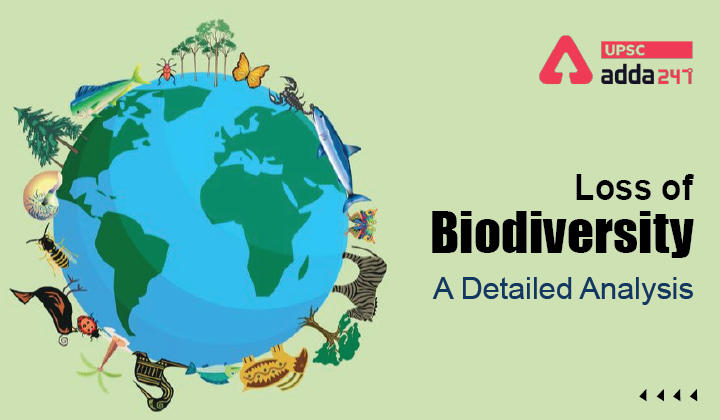Table of Contents
Loss of biodiversity
Before understanding the loss of biodiversity, let us first know
What is biodiversity?
- Biodiversity or biological diversity refers to the variety of living species on Earth, including plants, animals, bacteria, and fungi.
- The term biological diversity was used first by Arthur Harris (1916), who was an American botanist.
- The term, “biodiversity” was first coined by Walter G. Rosen in 1985.
- Generally, biodiversity is divided into three fundamental categories namely genetic diversity, species diversity, and ecosystem diversity.
What is loss of biodiversity?
- Biodiversity loss refers to the decline of biological diversity.
- In 2019, the United Nations had presented an ambitious report on biodiversity warning that out of a total of eight million, one million species are in danger of extinction.
- Some researchers even consider that we are in the middle of the sixth mass extinction event in Earth’s history.
- Earlier known mass extinctions wiped out between 60% and 95% of all species. It takes millions of years for ecosystems to recover from such an event.
Reasons of loss of biodiversity
- Climate change: Climate change impacts biodiversity at various levels: species distribution, population dynamics, community structure and the functioning of the ecosystem. There are signs that rising temperatures are affecting biodiversity, while changing rainfall patterns, extreme weather events, and ocean acidification are putting pressure on species already threatened by other human activities.
- Pollution: Biodiversity is getting affected from all types of pollution—air, water, land and light. Pollution, including from hazardous wastes and chemicals, is widely accepted as one of the main drivers of biodiversity loss.
- Habitat destruction: Habitat destruction is a process by which a natural habitat becomes incapable of supporting its native species. The organisms that previously inhabited the site are displaced or dead, thereby reducing biodiversity and species abundance.
- Invasive alien species: According to the United Nations Development Programme (UNDP), invasive alien species are the second biggest cause of loss of biodiversity in the world. They act as predators, compete for food, hybridise with native species, introduce parasites and diseases,
- Invasive alien species are species that have been introduced, either naturally, accidentally or intentionally, into an environment that is not their own.
- Overexploitation of the natural resources: Overexploitation can lead to resource depletion and put a number of threatened and endangered species at risk of extinction.
Effects of loss of biodiversity
- Extinction of species: Loss of biodiversity puts thousands of species in danger of extinction.
- Affect health of ecosystem: Biodiversity is critical for maintaining ecosystem health. Declining biodiversity lowers an ecosystem’s productivity and lowers the quality of the ecosystem’s services.
- Proliferation of pests: Biodiversity loss can also lead to the emergence of pests that damage
- Increase in CO2 emissions: Forests and oceans play the role of carbon sequesters. In the absence of these natural ecosystems, the carbon dioxide could rise to a whole new level.
- Spread of diseases: Biodiversity loss is likely to augment the spread of diseases. For example, if a lion kills an antelope, he will eat part of it. The remaining part will be eaten by other animals. However, if these other animals go extinct and are no longer able to consume the rest of the antelope, it may waste and in this wasting process, several kinds of diseases can be developed.
- Economic effects: If biodiversity loss leads to a decrease in biomass of feed, farmers will no longer be able to raise enough cattle due to the feed shortage, thus leading to loss of livelihood for locals. Similarly, if we lost bees, we would suffer from a serious decline in crop yields, which would lead the GDP to collapse and would also lead to an increase in famine.
Solutions of loss of biodiversity
- Government restrictions and policies
- Education
- Protection of species
- Protection of habitats
- Stop deforestation
- Prevent overhunting and overfishing
- Prevent species invasion
- Stop pollution
- Stop over-exploitation of resources
- Save energy
- Stop over-consumption
Read UPSC favourite topics





 TSPSC Group 1 Question Paper 2024, Downl...
TSPSC Group 1 Question Paper 2024, Downl...
 TSPSC Group 1 Answer key 2024 Out, Downl...
TSPSC Group 1 Answer key 2024 Out, Downl...
 UPSC Prelims 2024 Question Paper, Downlo...
UPSC Prelims 2024 Question Paper, Downlo...
